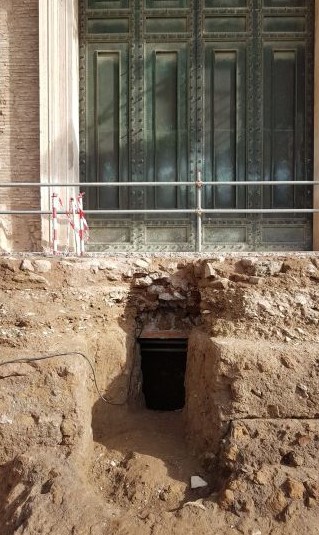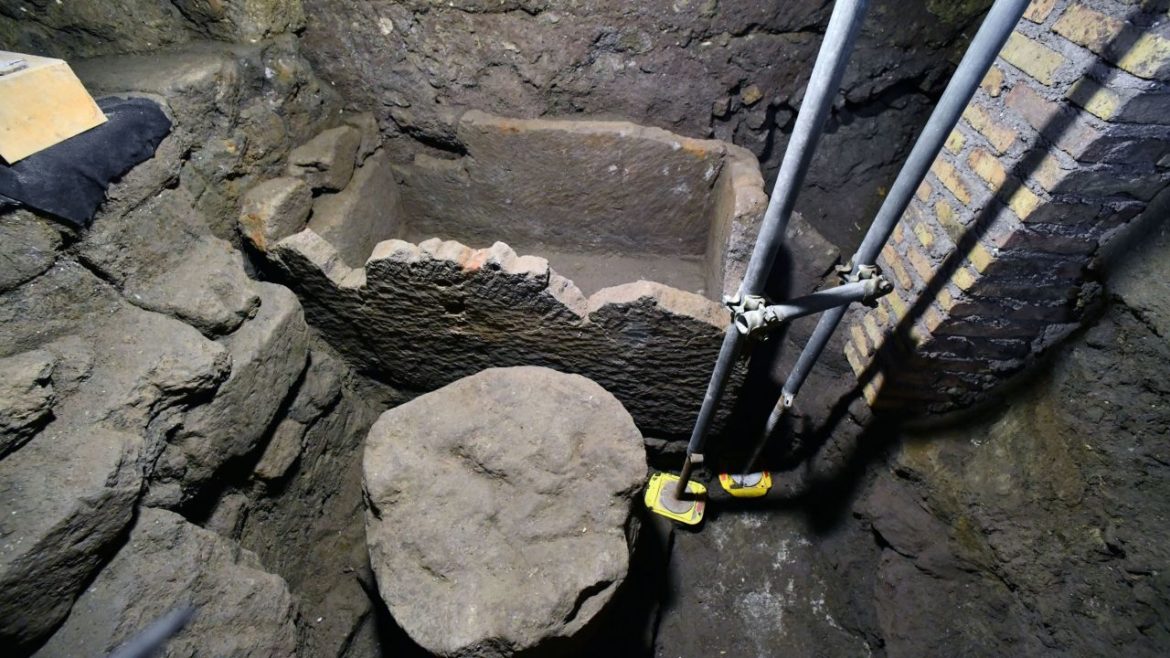ROME – A team of Italian archeologists announced the discovery of a sarcophagus found in the heart of Rome, as well as part of an ancient temple that may be linked to the city’s founding. The discovery was presented to the press on Friday by Dr. Alfonsina Russo, Director of the Archeological Park of the Colosseum, which encompasses the Colosseum, the Roman Forum, the Palatine Hill, and the adjacent Domus Aurea.
The archeological find in the Roman Forum is as extraordinary in its implications as it is unremarkable to the eye. While it is not likely that Romulus, the legendary founder of Rome, was buried within the site, it is likely where the citizens of the city venerated him.
A hidden stone tomb with circular votive altars was found in the northwestern corner of the Roman Forum underneath the senate house called Curia Julia, which was built in 44 B.C.E. under Julius Cesar. The tomb was revered by ancient Romans as holding the remains of the Eternal City’s founder, Romulus.
The stone tomb was empty, but that did not thwart speculation about it.

The northwest Roman Forum and Curia Julia [Image Credit: S. Ciotti]
Russo explained that the location of the tomb is significant. Not only was the tomb beneath Curia Julia, but specifically beneath the Comitium, where votes were cast during public assemblies in the ancient city. The tomb is also near the Lapis Niger, “the black stone,” a shrine of black marble. The Lapis Niger was believed to cause bad luck, because it was on that very spot, legend tells, where Romulus, after ruling for 37 years, was murdered by jealous members of the Senate. It is one of the oldest relics in the Roman Forum.
Russo said the temple was thus “located in a highly symbolic place for the political life of Rome.”
Romulus is said to have founded Rome in the 753 B.C.E. on the day his twin brother Remus died. In one version of the story, Romulus killed Remus out of anger over his mockery. In another version, Remus died after jumping a wall, which was interpreted as an omen that Romulus should be the city’s leader. Livy dates the event and the founding of Rome to April 21st of that year.
During his rule, legend tells that Romulus disappeared during a tornado while reviewing troops in Campus Martius, ascending to the heavens because of Mars, the god of war, who was also his father. According to Livy, Romulus’s ascension empowered Romans to expand their reach because it proved the gods were on their side.

The non-descript entrance to the Romulus site [Courtesy: parco archeologico del colosseo]
Romulus’ ascension also marked the formation of his cult, which later merged with the Sabine deity Quirinus, whose name means “spear” and may have been further syncretized with Janus, the god of beginnings. Quirinus was part of the Capitoline Triad, the major gods of early Rome, which also included Jupiter and Mars. Quirinus gives his name to the Quirinal Hill, the highest of the seven hills of Rome.
The Capitoline Hill lies between the forum and Campus Martius. Its summit held the temples to the Triad. The Capitoline Hill provided the rocks for the newly discovered temple. The 4.5 foot (1.4m) sarcophagus is made of tuff, a light volcanic stone quarried nearby.
Italian Archeologist Giacomo Boni first scientifically excavated the area in 1899, 120 years ago. He identified the location and the sarcophagus in his writings, but did not attribute anything or anyone to them. He wrote of a tree-trunk sized cylindrical stone and a “a rectangular, tub-shaped crate of tuff.”
Three decades later, a huge staircase to Curia Julia was built during the Mussolini regime, effectively covering the site until now. “We thought it had been destroyed,” said Russo.
Archaeologist Dr. Patrizia Fortini cautioned against assumptions about the site. She noted that the attributions to Romulus were a “suggestion based on ancient sources.” She noted that the location was suggested by the writings of the Roman scholar Marcus Terentius Varro, adding that the site “represents a place, which in history and in the Roman imagination, speaks about the cult of Romulus.”

The sarcophagus and circular votive possibly attributed to Romulus [courtesy: parco archeologico del colosseo]
Both Russo and Fortini dismiss that this is the burial site of Romulus. Russo explains that “this is not the tomb of Romulus but is a place of memory where the cult of Romulus was celebrated, a cenotaph.” Cenotaphs are memorial monuments for individuals buried elsewhere. The term derives from the Greek words κενός, meaning “empty”, and τάφος, meaning “tomb.”
In fact, historians and archeologists are skeptical about whether Romulus ever existed. While Rome’s founding date is known, the sarcophagus dates to 200 years later.
Still, the apotheosis story of the Eternal City was powerful. It was already ancient when Rome transitioned from a republic to an empire 2,000 years ago, and the story is still repeated today. “All myths and legends have an element of truth,” Russo said. “I am convinced that there was a founding hero.”
The Wild Hunt is not responsible for links to external content.
To join a conversation on this post:
Visit our The Wild Hunt subreddit! Point your favorite browser to https://www.reddit.com/r/The_Wild_Hunt_News/, then click “JOIN”. Make sure to click the bell, too, to be notified of new articles posted to our subreddit.
